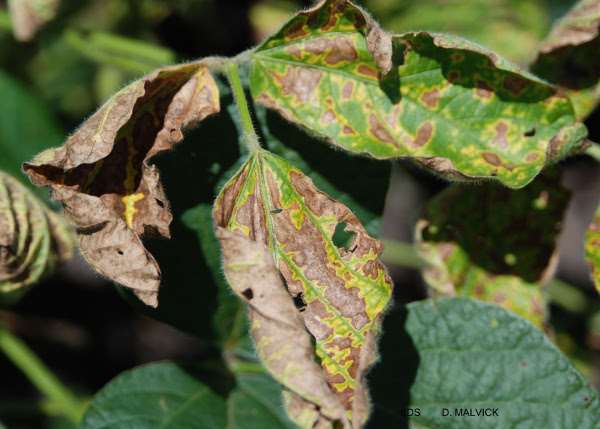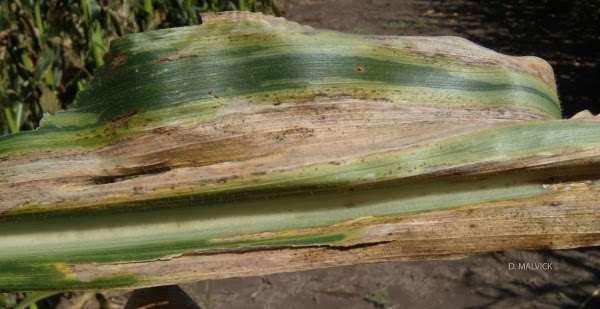By Dean Malvick
Two common themes across much of Minnesota’s croplands in 2016 were rain and high yields. Conditions were also favorable for diseases in a number of areas. Sometimes there was obvious damage and yield loss, and in other cases the role that disease played in holding back yields from even higher levels was unclear. Disease was again highly variable across the state, even more inconsistent than the weather that favors disease development. Some diseases were common over wide areas, but others were much more scattered. With harvest nearly complete it is once again a good time to review some of the diseases issues that occurred across Minnesota in 2016.
Soybean
Sudden death syndrome (SDS) was widely observed in southern Minnesota. Frequent rains favored this disease. Planting date also seemed to be a factor. High levels of SDS developed in research plots that were planted in early May and much less disease developed in plots planted in late May. The effect of this disease on yield can be difficult to determine because it tends to be patchy in fields and often occurs where conditions favor high yields. Our SDS field research studies once again showed the importance of using resistant soybean varieties as well as the potential value of selected seed treatments to manage SDS.

There was a heightened concern for white mold in July based on the frequent rainfalls and early observation of disease development. Recall that wet weather along with relatively cool temperatures during flowering periods are what this disease prefers. However, warm temperatures during the critical July to early August period seemed to suppress this disease in most areas. Although white mold was widely observed, it appears that few areas (with some exceptions) had significant yield loss due to this disease.
Rhizoctonia root rot caused significant problems in some soybean fields, especially in central Minnesota. The most common set of conditions that favor Rhizoctonia root rot are warm and moist soil for the first 2-3 weeks after planting. This most often occurs in fields after mid-May. Looking back, this disease was not a major problem in 2015, but was one of the most common soybean diseases in parts of Minnesota in 2013 and 2014.
Brown stem rot (BSR) was also favored by this seasons environmental conditions in some areas. For example, some fields around Waseca had high levels of BSR. The leaf symptoms were likely confused with SDS in some fields until plants were looked at closely. The only way to know for sure if BSR is a problem in a field is to split stems in mid to late-August to look for the browning in the pith.
Other soybean diseases that were observed at notable, but rarely if ever at yield-reducing, levels in some fields include Septoria brown spot starting in June, bacterial blight in July and August, and pod and stem blight in August.
Corn
Goss’s leaf blight and wilt was seen at significant levels in multiple fields, especially in fields damaged by hail in July in southwest and central MN. Significant yield losses were reported from a few fields. Thus, Goss’s wilt continues to be a disease to watch for given its potential to reduce yields. In fields with confirmed risk of Goss’s wilt, especially where it was confirmed previously, highly resistant hybrids should be considered in future years when corn is planted.

Given its prevalence last year in southern MN and IA, northern corn leaf blight (NCLB) was perhaps the most anticipated and watched-for corn disease. Fortunately, it did not became a significant problem in most areas in Minnesota. Initial reports of this disease in southern MN in July raised the level of concern, but then the full set of favorable factors needed to get this disease really ‘going’ never came together. Unfavorable combinations of rainfall and temperature in July to mid-August when the crop is most susceptible to yield loss likely limited disease development. Later in the season it was not difficult to find NCLB lesions in many fields, a reminder that there is a fresh crop of inoculum of the NCLB fungal pathogen in many areas that could incite problems in 2017 if conditions favor for disease development.
Other corn diseases reported include seedling diseases, stalk and ear rots from many fields in southern and central Minnesota, and Physoderma leaf spot. Of these, stalk rots late in the season appeared to be the biggest problem in many fields.
New corn diseases found recently in the Midwest. A new disease of corn called bacterial leaf streak, caused by the bacterial pathogen Xanthomonas vasicola pv. vasculorum, was confirmed in the U. S. and Minnesota for the first time in 2016. Following confirmation in Nebraska, surveys were initiated in a number of states and the disease has been confirmed in at least nine states, including, Minnesota, Iowa, South Dakota, Illinois, Kansas, Colorado, Texas, Oklahoma and Nebraska. In Minnesota it was confirmed two counties, one in the southeast and one in the southwest. Corn leaves with this disease have narrow tan to brown streaks that are up to several inches long, and the symptoms are similar to gray leaf spot. The potential for this disease to cause significant yield loss is unknown, but is thought to be low.